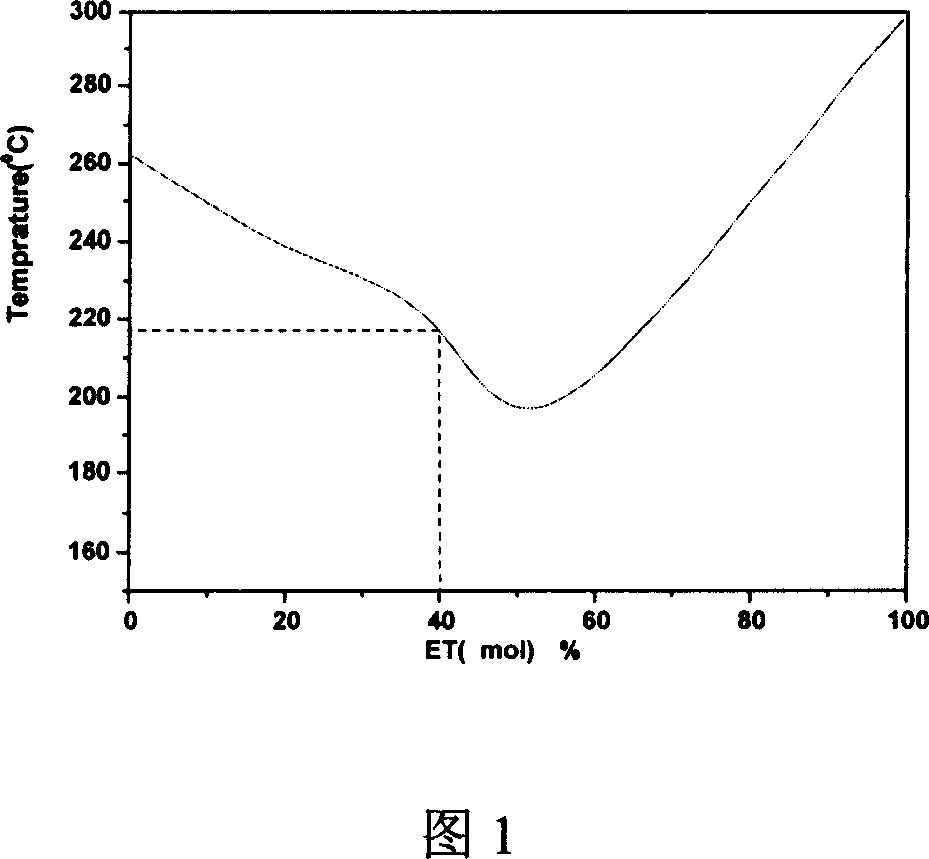PET/PTT copolyester fiber and its production process
A copolyester and fiber technology, applied in the field of PET/PTT copolyester fiber and its production, can solve the problems of insufficient performance, poor thermal stability, low strength, etc. The effect of improving quality
- Summary
- Abstract
- Description
- Claims
- Application Information
AI Technical Summary
Problems solved by technology
Method used
Image
Examples
Embodiment 1
[0021] Preparation of ET40 (ET unit accounts for 40% in copolyester, TT unit accounts for 60%) filament
[0022] Before spinning, we must first select the spinning temperature according to Figure 1. It can be seen that when the ET% is 40%, the corresponding temperature value is 218°C. At this time, the spinning temperature can be set to 218°C. Pre-crystallize ET40 with an intrinsic viscosity of 0.636dL / g at 80°C for 12h, and then vacuum-dry it at 110°C for 48h to control the moisture content to less than 50ppm. The dried slices are put into the screw to melt and extrude into the spinning box, passed through the metering pump, sprayed out from the spinning assembly into filaments, then cooled by blowing, stretched by two hot rollers, and finally wound into silk. The spinning process is listed in Table 1
[0023] project
[0024] PTT
Embodiment 2
[0026] Preparation of ET80 (80% ET units and 20% TT units in copolyester) filaments
[0027] Before spinning, the spinning temperature should be selected according to Figure 1. It can be seen that when the ET% is 80%, the corresponding temperature value is 253°C. At this time, the spinning temperature can be set to 253°C. Pre-crystallize ET80 with an intrinsic viscosity of 0.707dL / g at 100°C for 12h, and then vacuum-dry it at 120°C for 48h to control the moisture content to less than 50ppm. The dried slices are put into the screw to melt and extrude into the spinning box, passed through the metering pump, sprayed out from the spinning assembly into filaments, then cooled by blowing, stretched by two hot rollers, and finally wound into silk. The spinning process is listed in Table 3
[0028] project
[0029] ET80
PUM
| Property | Measurement | Unit |
|---|---|---|
| elongation at break | aaaaa | aaaaa |
Abstract
Description
Claims
Application Information
 Login to View More
Login to View More - R&D
- Intellectual Property
- Life Sciences
- Materials
- Tech Scout
- Unparalleled Data Quality
- Higher Quality Content
- 60% Fewer Hallucinations
Browse by: Latest US Patents, China's latest patents, Technical Efficacy Thesaurus, Application Domain, Technology Topic, Popular Technical Reports.
© 2025 PatSnap. All rights reserved.Legal|Privacy policy|Modern Slavery Act Transparency Statement|Sitemap|About US| Contact US: help@patsnap.com


